Swim bladder disease is not actually a disease.
Instead, it is a secondary symptom of damage to the swim bladder due to common betta fish diseases, such as:
- Constipation
- Bloating
- Dropsy
- Parasites/Bacterial infection
- Poor water quality
The swim bladder is a gas-filled internal organ in fish. This organ usually regulates a betta’s buoyancy and helps the fish swim.
When the swim bladder gets damaged, it causes buoyancy issues. You may notice your betta swimming sideways or sinking to the bottom of the tank.
Your betta can make a full recovery from swim bladder disease caused by a minor illness. But more serious causes like dropsy may be fatal.
Early treatment for swim bladder disease increases your betta’s chance of survival.
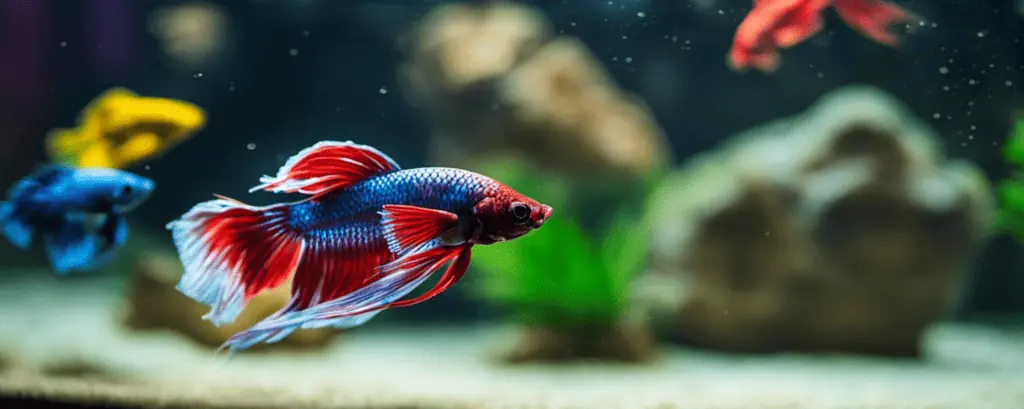
Table of Contents
Causes of Swim Bladder Disease in Betta Fish

Swim bladder disease is a common fish ailment.
Dealing with swim bladder issues in your betta is difficult.
There are several causes of swim bladder disorder. Pinpointing the exact cause is a challenge.
Genetics
It is rare, but some betta fish have a birth defect in their swim bladders.
This birth defect is more common in double-tail betta types.
Bettas born with a swim bladder disorder show symptoms at an early age. They never have normal swimming patterns.
Some bettas grow out of swim bladder disease as they get older. But this is rare, and the disease is usually fatal for them.
Poor Water Conditions
Ideal Water Parameters for a Betta Fish Tank Include the following:
- Temperature: 78-80° degrees Fahrenheit (25.5-27° C)
- pH: 6.5-7.5
- Ammonia and Nitrite: 0 ppm
- Nitrate: < 40 ppm
- gH: 3-4 dGH (50-66.7 ppm)
- kH: 3-5 dKH (53.6-89.4 ppm)
- Minimum Tank Size: 5 Gallons
Dirty water harbors harmful bacteria and parasites. These microorganisms cause a variety of illnesses related to swim bladder disease.
Improper water parameters also put your betta at risk for developing swim bladder disease.
Betta fish are sensitive to fluctuations in water conditions.
Low tank temperatures slow down a betta’s digestive tract. Sudden temperature changes may also send a betta into shock.
These events can cause constipation and bloating, leading to swim bladder disease.
Digestive Issues

Your betta’s diet may also cause swim bladder disease.
Pellets and freeze-dried foods expand in a betta’s stomach. This causes bloating and constipation, which may develop into swim bladder disease.
Soaking these foods in tank water before feeding them to your betta helps prevent these issues.
If your betta eats too fast, it is also at risk for swim bladder disease.
Eating too quickly causes swelling in a betta’s gastrointestinal tract. This makes the swollen stomach press into the swim bladder.
Overfeeding your betta causes the same issue and a higher chance of constipation.
When inflammation in the intestinal tract causes bloating, your betta has an increased risk of developing swim bladder disease.
As I mentioned before, low water temperatures slow down a betta’s digestion.
Keeping temperatures between 78-80° degrees Fahrenheit (25.5-27° C) prevents disturbing the digestive process.
Injuries

Injuries to a betta’s swim bladder can cause symptoms of swim bladder disease.
A betta in a community tank has a higher risk of injury due to fighting.
Bettas can also injure themselves on sharp tank decorations or by jumping out of the tank.
Ensure your tank decorations do not have any sharp edges or rough textures.
Keeping a lid on the aquarium prevents your betta from jumping out. You must also ensure your betta does not jump out while you clean the tank.
Bacterial or Parasitic Infection

Bacterial or parasitic infections can sometimes attack a betta’s organs.
The infection causes swollen organs and puts pressure on the swim bladder.
Signs of a bacterial or parasitic infection may include bloating or pale, stringy feces.
Harmful bacteria and parasites thrive in dirty water. These tiny organisms may also enter the tank through contaminated plants or infected fish.
Always rinse new plants in tank water before adding them to your aquarium. This removes harmful bacteria or parasites.
If you have a community tank, you must quarantine new fish for at least 4-6 weeks. Quarantine protocols ensure the fish do not carry any contagious diseases.
Other Causes
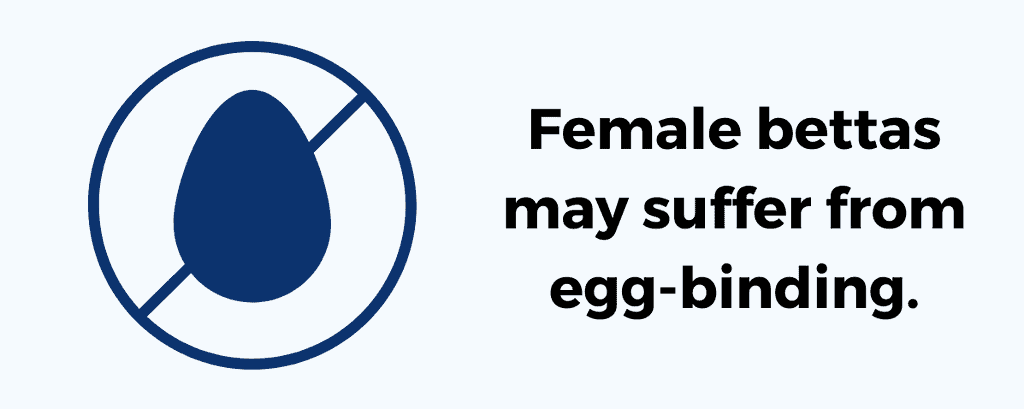
There are a couple of other causes of swim bladder disease worth mentioning even though they are rare.
Female bettas may suffer from egg-binding. Egg-binding happens when the betta cannot release her eggs.
This condition is rare in female bettas because they usually reabsorb unfertilized eggs. But egg-binding puts a lot of pressure on internal organs, including the swim bladder.
Another rare cause of swim bladder disease is fatty deposits in the liver. These fatty deposits cause swelling in the liver and disrupt the function of the swim bladder.
Kidney cysts also put excess pressure on the swim bladder. Bettas rarely have kidney cysts, but they are still a possible cause of swim bladder disease.
Unfortunately, there is no treatment for kidney cysts and the condition is fatal.
Common Swim Bladder Disease Symptoms in Betta Fish
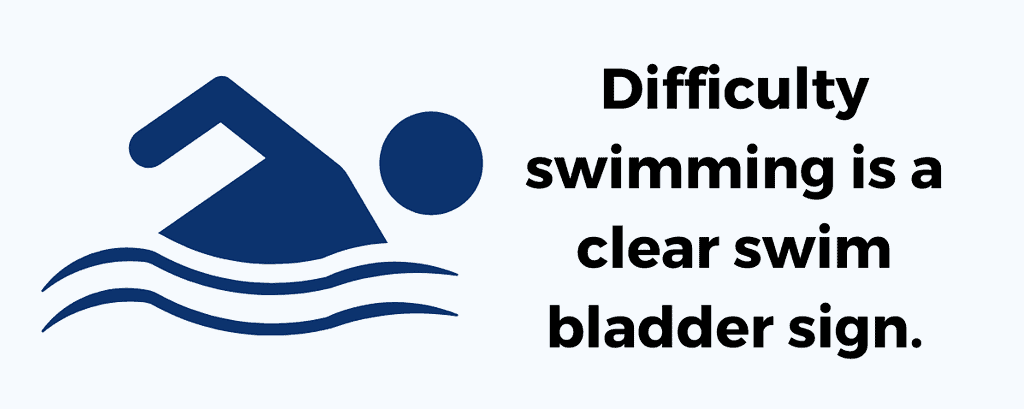
The symptoms of swim bladder disease overlap with the underlying illness causing the disorder.
Understanding the variety of symptoms helps you make a proper diagnosis.
Treating swim bladder disorder at the first sign of symptoms helps your betta quickly recover.
Difficulty Swimming
The most obvious symptom of swim bladder disease is difficulty swimming.
Bettas with swim bladder disease have problems staying upright.
You may see your betta floating sideways or upside down. Sometimes, swim bladder disorder causes the betta to sink to the bottom of the tank.
If your betta gets stuck at the bottom of the tank, it cannot swim to the surface for air. Your betta may also suffer from abrasions caused by swimming close to the substrate.
Swimming in one area is challenging because the betta keeps sinking down or floating up.
Bloating
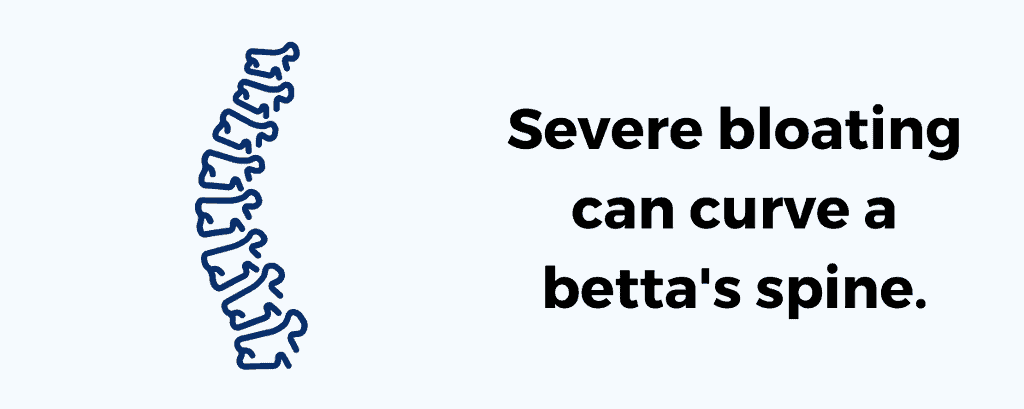
A bloated belly is the most common symptom of swim bladder disorder.
Severe bloating may cause an “S” curve in your betta’s spine.
Bloating is usually caused by feeding issues. Swallowing air, overfeeding, and constipation all lead to abdominal swelling.
Parasitic worms and severe bacterial infections can also cause a distended belly.
Any swelling can put extra pressure on a betta’s swim bladder.
Bloating is a severe condition. You must take action quickly, especially if your betta has trouble swimming.
Constipation

Constipation causes pressure on the swim bladder and bloating.
A poor diet is the main reason bettas get constipated.
Besides protein, bettas also need adequate fiber in their diet. Daphnia is an excellent source of fiber and acts as a laxative for constipation relief.
Sometimes, constipation occurs because pellet foods expand in the stomach. Avoid this by soaking the pellets in tank water before feeding your betta.
You must also rehydrate freeze-dried foods due to their expansion in the stomach.
Loss of Appetite
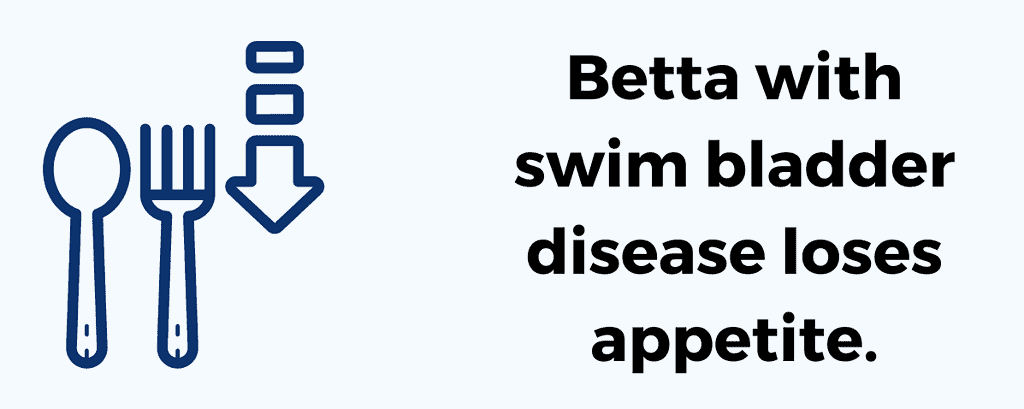
A betta with swim bladder diseases likely has a loss of appetite.
The lack of appetite stems from bloating and constipation issues.
You may see your betta spitting out food or refusing to eat during feeding time.
A lack of appetite may also result from a bacterial infection or parasite infestation.
You must treat the underlying issue immediately if your betta does not eat.
Without food, your betta may suffer from malnutrition and weight loss. This weakens the immune system and makes recovering from swim bladder disease more difficult.
Clamped Fins

It is not uncommon for a betta with swim bladder disease to have clamped fins.
Clamped fins mean your betta keeps its fins close to the body.
This symptom often happens when a betta becomes stressed due to illness or poor water conditions.
Preventing Swim Bladder Disease in Bettas

Prevention methods for swim bladder disease are simple.
Keeping your betta healthy involves steps for proper care.
Establishing good feeding habits and routine tank maintenance keeps your betta healthy.
Maintain Proper Water Conditions
Maintaining proper water conditions is the best way to ensure your betta stays healthy.
Regular water changes remove many harmful toxins and bacteria from your aquarium water.
Do partial water changes every week. Remove no more than 20% – 25% of the water at one time.
Taking too much water from your aquarium causes an imbalance of beneficial bacteria. This bacteria is crucial in maintaining a proper nitrogen cycle.
If you use tap water to fill your aquarium, add a water conditioner before pouring it into the betta tank. A water conditioner removes toxic chlorine and chloramine from tap water.
During the water change, use a gravel vacuum to remove debris from the substrate. Leftover food and fish waste increase ammonia levels in your tank.
You must also remove algae from the glass sides of the tank.
Use an aquarium testing kit to check pH, ammonia, nitrite, and nitrate levels in the water.
The ideal pH for betta fish is between 6.5-7.0, which is neutral.
Ammonia and nitrite levels must be 0 ppm. Acceptable nitrate levels are anything below 40 ppm.
Install a filtration system for water circulation and bacteria removal. Choose a sponge filter with a low current so it does not interfere with your betta’s swimming ability.
Maintain stable water temperatures with a quality aquarium heater. Place the heater next to the filter to ensure even heat distribution throughout the tank.
Optimal temperatures for bettas range from 78-80° degrees Fahrenheit (25.5-27° C).
Keeping your aquarium clean prevents most causes of stress and disease in your betta.
Provide a Balanced Diet
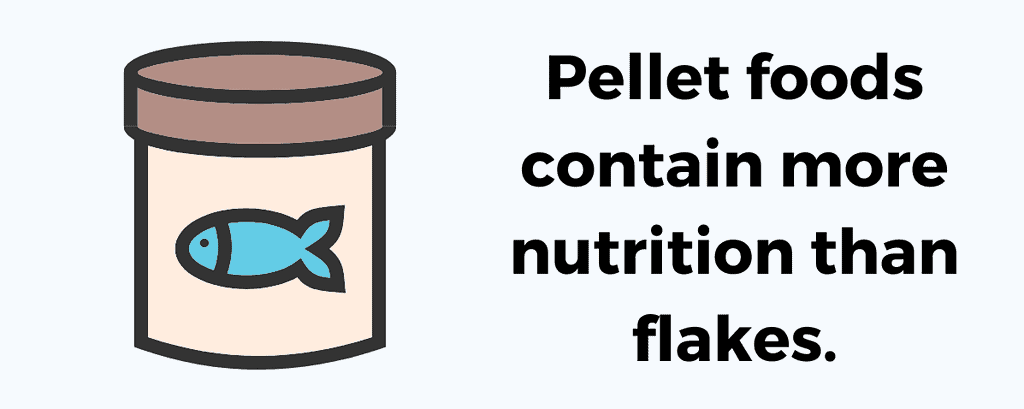
As a carnivore, your betta needs a protein-rich diet.
You must also provide essential vitamins and minerals. These include vitamin A, iron, and calcium.
Choose high-quality betta pellets with few fillers. Pellet foods are less messy than fish flakes and usually contain more nutrition.
Provide a varied diet for added proteins and other nutrients. Live, freeze-dried, and frozen foods are widely available.
Some excellent alternate food choices for bettas include:
- Daphnia
- Mosquito larvae
- Brine shrimp
- Blood worms
Ensure you buy live foods from a reputable source. Doing this reduces the risk of parasites and other diseases.
Thaw frozen foods in a cup of tank water.
Avoid getting any of the frozen water in the tank. This prevents exposing your betta to contaminated water.
You must rehydrate freeze-dried foods in tank water as well. Freeze-dried foods expand in water; you do not want this happening inside your betta’s stomach.
Rehydration also makes the freeze-dried food easier for your betta to eat.
Avoid Overfeeding

Bettas are greedy eaters. You must take special care to avoid overfeeding your fish.
Overfeeding causes bloating and constipation issues in bettas.
Excess food also makes your tank water cloudy and increases ammonia levels.
Feed your betta two small meals per day instead of one large meal. This allows for better digestion and prevents overfeeding.
The proper amount of food for your betta is 2-4 pellets per meal.
Set aside the same day every week for fasting your betta. A day of fasting lets your betta digest leftover food in the stomach.
Avoid Rough Handling or Injury

Injuries to the swim bladder may cause symptoms of swim bladder disease in your betta.
Avoid rough handling any time you must remove your betta from the tank.
Take special care during cleaning, as well.
Inspect tank decorations for sharp edges and course textures before placing them in your betta tank.
Rounded objects like coconut caves and smooth rocks make excellent hiding places for your fish.
If your betta is in a community tank, reduce the risk of injury by avoiding overcrowding.
Bettas are aggressive fish, so you must also choose tank mates with a calm temperament.
Treatment Options for Swim Bladder Disease in Bettas
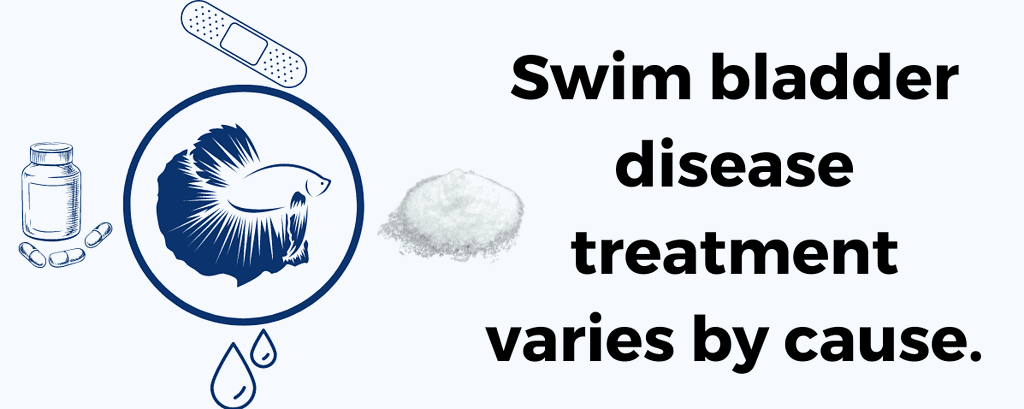
Treatment options for swim bladder disease in bettas depend on the underlying cause.
Minor injuries usually heal with aquarium salt baths.
Bacterial infections need antibiotic treatment. Depending on the severity of the infection, you may need a prescription medication from your veterinarian.
Epsom salt bath treatments help relieve constipation and bloating issues.
Use a separate quarantine tank for any treatment.
Some aquatic plants are sensitive to medications.
Aquarium salt can kill tank mates like snails and shrimp.
You may notice an improvement in your betta’s condition within 2-3 days after treatment.
Keeping Your Betta’s Swim Bladder Healthy
Swim bladder disease is a serious issue for betta fish.
Without a healthy swim bladder, your betta cannot swim properly.
Regularly check on your betta’s appearance and behavior for signs of illness.
Treating the disease as soon as symptoms appear prevents further complications. Without prompt treatment, your betta could die.
Maintaining a clean environment and providing your betta with a healthy diet go a long way in preventing swim bladder disease.
To help determine common betta illnesses and treatment options, head over to our large list at the link.


